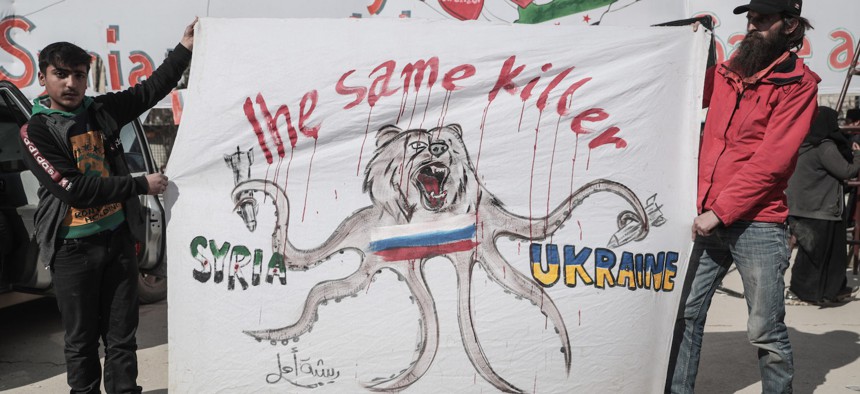
Syrian demonstrators hold a banner in solidarity with the Ukrainian people in their war against Russia during a demonstration against the Syrian regime on the 11th anniversary of the Syrian Revolution, March 15, 2022. picture alliance via Getty Images / Anas Alkharboutli
Russia Increasing Aggression Over Syria As Ukraine Losses Mount
“It’s a bit concerning,” CENTCOM air chief says, as Russia’s strikes put U.S. forces in Syria at greater risk.
NATIONAL HARBOR, Md.—Russian military leaders have responded to losses in Ukraine by escalating the air campaign over Syria, the U.S. air commander for the Middle East operations warned Monday.
“Some of the personalities of Russian leadership that [are] in Syria right now, some of those Russian general officers frankly failed in Ukraine,” said Lt. Gen. Alex Grynkewich, commander of the 9th Air Force, which includes Central and Southwest Asia.
“Now they are in Syria, and my assessment is they are trying to make a name for themselves again and regain favorable standing within the Russian armed forces,” Grynkewich said at the annual Air, Space & Cyber Conference. “Frankly it’s a bit concerning where we have forces on the ground and armed Russian aircraft that fly over them.”
The U.S. has about 900 troops still in Syria, and they are in contact with the Russian military “every single day, intercepting them, escorting them, and making sure our forces on the ground remain safe,” he said.
Russia’s increased aggression in Syria has included incursions into the airspace near the U.S.-operated An-Tanf garrison near the Iraq border. For previous flights, Russia notified the U.S. and deconflicted the moves, Grynkewich said.
“They stopped giving us that phone call,” he said.
In Ukraine, Russia lost at least 55 aircraft to surface-to-air missile strikes because of tactical errors early in the invasion—some of which may have been a result of using the same air war tactics over Ukraine that it did in Syria. In Syria, Russia’s air operations were largely uncontested and they deconflicted airspace with the U.S.
When it launched operations in February, Russia did not target Ukrainian surface-to-air defense systems, said Gen. James Hecker, commander of U.S. Air Forces-Europe.
“They just hadn’t practiced taking out these [air defense systems] before, and when they determined that they needed to do that, they just weren’t skilled and didn’t have the weaponry to take them out,” so they kept their distance and fired longer-range munitions, Hecker said.
Most of Russia’s fighter jet losses were a result of surface-to-air fires, Hecker said. Ukraine, with the help of an unnamed U.S. contractor, has also been able to retrofit some of its MiG-29s with U.S. advanced air-to-ground HARM missiles—which have taken out some of the Russian air defense radars.




